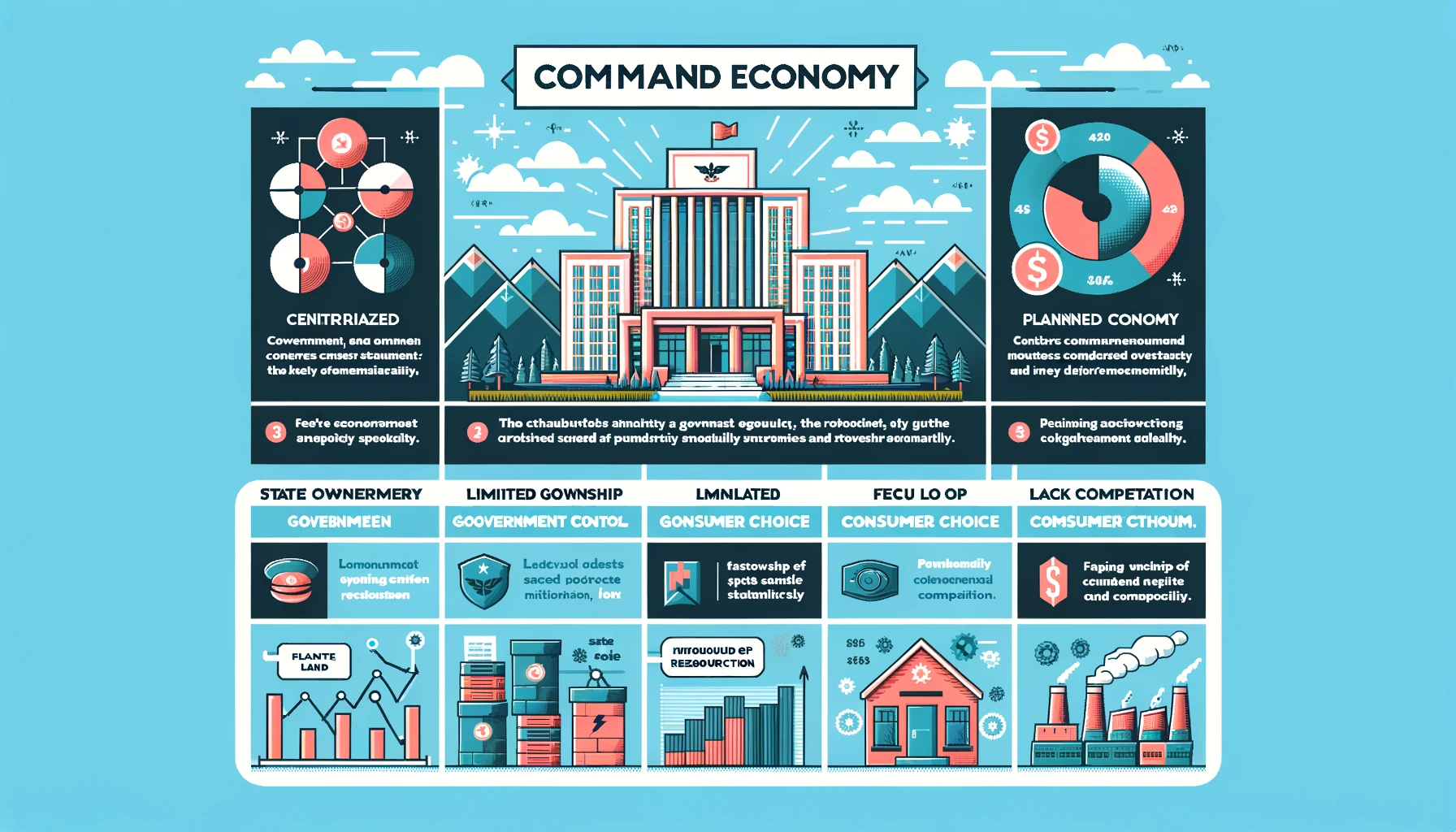Command economy is also called planned economy.The command economy is characterized by government economic sovereignty, rather than consumer sovereignty. The political leadership makes all major economic decisions. It determines inputs and outputs (prices, labor conditions, what will be produced. how resources will be allocated), thereby determining consumption patterns. Command economies are based on the belief that central planning and central control can achieve increased productivity and reduced inequalities more efficiently than a market system.
Advocates of the command economy argue that competition is inherently wasteful and that markets respond to what it is profit-able to produce, not what is most useful or necessary. Though no system has eliminated the market completely, market relations are secondary to planned production. At best. markets are seen as useful for distributing what is produced, not for deciding what ought to be produced. Ideologically, command economies are based on the belief that competition is selfish and wasteful, that man is basically cooperative.
Socialism or communism and a command economy are not necessarily synonymous. Theoretically, private ownership and state determination of production are possible. Nazi Germany approximated this scheme in some respects. In fact, most countries that have attempted to replace the market with central-government direction also have emphasized state ownership of the means of production. Markets have proven too flexible. however, to eliminate competition entirely.
5 Characteristics Of A Command Economy.

In a command economy, all decisions of economy are made by centralized government. The government owns the land and the means of production. It does not depend on the laws of supply and demand that operate in a market economy.
The government creates a central economic plan . The five-year plan establishes economic and social objectives for each sector and region of the country. Short-term plans convert goals into actionable objectives.
The government allocates all resources according to the central plan. Try to use the capital, work and natural resources of the nation in the most efficient way possible. It promises to use the skills and abilities of each person to their maximum capacity. It seeks to eliminate unemployment.
The government has monopoly businesses . These are industries considered essential for the objectives of the economy. That generally includes finance, public services and automotive. There is no internal competition in these sectors.
Command economies can quickly mobilize large-scale economic resources . They can execute massive projects, create industrial power and fulfill social objectives. They are not slowed down by individual demands or environmental impact statements.
Command economies can completely transform societies to fit the government’s vision. The new administration nationalizes private companies.
Real Examples of Command Economy.
These are some examples of the most well-known countries with economy of command:
Belarus – This former Soviet satellite remains a managed economy. The government owns 80 percent of its business and 75 percent of its banks.
China: after the Second World War, Mao Tse Tung created a society governed by communism. It imposed a strictly planned economy. The current leaders are moving towards a market-based system. They continue to create five-year plans to delineate economic goals and objectives.
Cuba: Fidel Castro’s revolution in 1959 installed communism and a planned economy. The Soviet Union subsidized the Cuban economy until 1990. The government is slowly incorporating market reforms to stimulate growth.
Iran: the government controls 60 percent of the economy through state-owned enterprises. It uses price controls and subsidies to regulate the market. This created recessions, which he has ignored. Instead, he devoted resources to expanding his nuclear capacity. The United Nations imposed sanctions, worsening its recessions. The economy improved once the nuclear trade agreement ended sanctions in 2015.
A command economy, also known as a planned economy, is an economic system where the government or a central authority makes all decisions regarding the production and distribution of goods and services. Here’s a guide to the characteristics of a command economy in a tabular format:
| Characteristic | Description |
|---|---|
| Central Planning | A central authority, typically the government, plans and directs all economic activity. |
| Government Control | The government controls all major sectors of the economy, including industries, agriculture, and trade. |
| Resource Allocation | Resources and roles in the production process are allocated by the state, rather than determined by market forces. |
| Production Goals and Quotas | The government sets production goals and quotas for different industries to meet the needs and priorities of the state. |
| Limited Consumer Choice | Due to government control over production, consumers often have limited choices regarding products and services. |
| Price Control | Prices for goods and services are often set by the government, not determined by market demand and supply. |
| State Ownership of Means of Production | The means of production, such as factories and farms, are often owned and operated by the state. |
| Emphasis on Collective Goals | Economic decisions are made based on collective goals and societal needs, rather than individual profit motives. |
| Reduced Income Inequality | Since the government controls wages and employment, there is often less income inequality compared to market economies. |
| Limited Entrepreneurship | Entrepreneurial activities and private businesses are limited, as the state controls economic activities and investments. |
| Focus on Long-term Planning | Command economies focus on long-term planning and goals, sometimes at the expense of short-term efficiency and flexibility. |
| Reduced Competition | Since the state controls and manages industries, there is little to no competition within the domestic market. |
This table outlines the key characteristics of a command economy, highlighting its distinct approach to managing economic activities compared to market economies.
Conclusion
Command economies possess distinct characteristics that differentiate them from market economies. The centralized decision-making, government control over resources, limited individual freedom, and price regulation are key features that define a command economy. While this economic system offers certain advantages such as stability and long-term planning, it can also limit individual choices and entrepreneurship. A thorough understanding of these characteristics is essential in comprehending the complexities and implications of a command economy.
